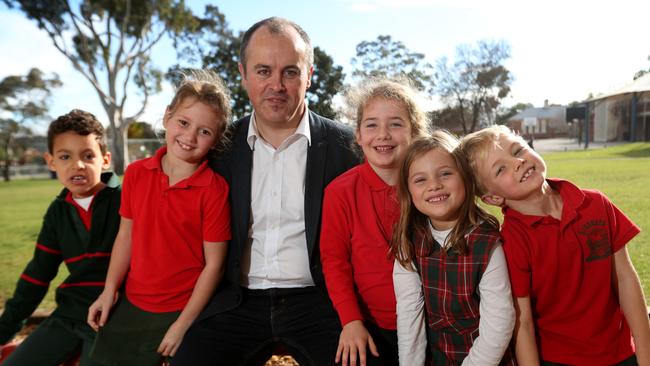Highgate Primary, Unley High lead bilingual schools push, French
Two South Australian schools say ‘oui s’il vous plait’ to French studies and the rapid growth of bilingual learning.

Loic Calvez will be looking to expand his French teaching staff at Highgate Primary and Unley High schools, in Adelaide’s east, in the coming months as he prepares for an expansion of the bilingual program that he oversees.
Calvez, who was born and grew up in France and worked as a teacher and pedagogical adviser in his early career, directs the school’s bilingual and binational programs on secondment from the French education ministry.
“We’re talking about hiring some French teachers to come in, we’re talking about up advertising the jobs in France, but we need to get more facilities with visas, and searching for teachers established here with a French primary school background is difficult.”
School teachers with a language major increasingly are rare in Australia as fewer students study languages in high school, but there is an ongoing need as more bilingual schools open.
There are 28 bilingual schools nationally, with almost half in Victoria alone, offering programs in Chinese, Korean, Japanese, Italian, French, Indonesian, Auslan, German and Vietnamese.
There are more Japanese programs than other languages, with eight schools offering it as a bilingual stream, followed by six French and six Chinese programs.
The bilingual program began at Highgate this year in response to French naval design and construction company DCNS’s move to South Australia, after winning the $50 billion future submarines contract. Several French families have arrived, and as the European school year finishes more are expected for the third school term and next year.
The primary school, under Calvez’s direction, is teaching Reception and Year One in French and English. Up to 80 per cent of each day is in French, including lessons in visual arts, maths, humanities, French language, reading and writing. Next year the bilingual program will expand to Year Two.
At Unley High school, former prime minister Julia Gillard’s alma mater, students are taught some subjects in French and a bilingual program will begin in Year Eight next year.
While schools around the nation generally have Australian teachers with a second language in their bilingual classes, or the odd native speaker, Highgate’s teachers are French or Canadian.
Of the 51 students in the early-years bilingual stream, 30 per cent come from French-speaking countries, 20 per cent from France and 50 per cent from the wider community.
“It’s not about learning French but learning in French and the opportunity to be bilingual, quickly and easily,” Calvez says.
“Learning French will be an added value for them when they will be on the employment market because of the industries around the submarines. It will be in demand and it will make the difference between two candidates.”
The schools follow the Australian curriculum but must also teach to the French curriculum in a blended course.
Other schools also offer content and language integrated learning programs, where subjects in the curriculum, such as music or science, are taught in a second language.
Modern Language Teachers Association of Victoria project manager Kylie Farmer, a former Japanese teacher and co-ordinator at bilingual school Huntingdale Primary, says there is a long tradition of bilingual schooling in her home state, particularly in German and French.
The need and interest in bilingual education is increasing, with new programs under consideration and a high interest in parents looking to widen their children’s horizons.
“In 1997 the Victorian government established the bilingual schools project which contained 13 primary schools in a number of languages,” Farmer says.
“Recently an Italian program became part of this program, and a Spanish one is being considered.
“There’s also a strong parents group that wants to introduce another French bilingual school and that’s community-driven.”
Many programs are parent-driven, with community interest boosting enrolments.
Not all students come from English as a second language backgrounds, she says, with parents wanting their children to have a greater depth of learning.
“Sometimes it’s government or community-led, or school-led,” she says.
“The demand is growing from parents and the number of children are growing. Parents are going quite a distance out of their zone to attend a special language school. They want to learn a language from an early age and have all the benefits of that.”
Bilingual schools also can attract new families to areas where they are based. But Farmer says most schools will have a diversity of students from different backgrounds, including no language experience at all.
Children’s brains are like sponges, or so the saying goes, and Farmer says doing subjects at a CLIL school or an entire curriculum in a second language can help expand a student’s learning capabilities. She says many also show higher results in National Assessment Program — Literacy and Numeracy tests despite studying maths in a second language.
CLIL programs offer more than just a standard hour a week of languages, which Farmer says can leave students frustrated because they barely move beyond basic colours and numbers, often years below their learning standards.
Teaching in a second language also can be challenging because there can be a lack of bilingual support material or textbooks.
Many teachers have a second language before starting their education degree, and she says there are no specific bilingual teaching courses available.
“The challenge can be that the work required is incredibly intensive, and when you’re in a bilingual school you’re creating the program and need the resources, and need to learn the content in that language,” she says. “Where in English you could grab a book off the shelf, you can’t often do that with another language.”
MLTAV facilitates professional learning and teaching workshops to help boost skills and allow networking, with teachers from the other states attending.


